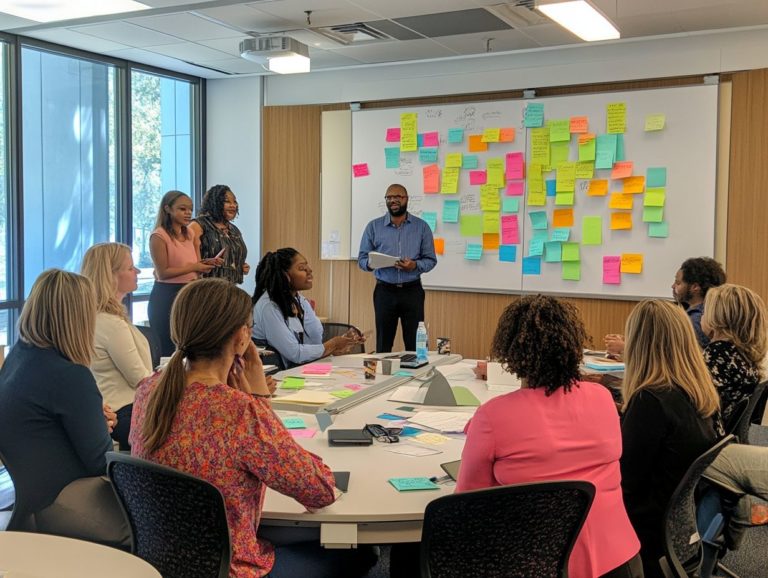5 Common Myths About Leadership Development
Leadership development is often clouded by misconceptions that can prevent both you and your organization from achieving your true potential.
Many believe that great leaders are born rather than made, or that only top executives require leadership training. These myths can significantly restrict growth and innovation.
This discussion delves into five prevalent myths about leadership development, outlines what effective programs should include, and examines how you can measure success while overcoming challenges.
Embrace this opportunity to clarify your path to helping leaders grow at every level.
Contents
- Key Takeaways:
- 1. Leadership Is a Natural Talent
- 2. Only Certain People Can Be Leaders
- 3. Leadership Development Is Only for Top Executives
- 4. Leadership Development Is Expensive
- 5. Leadership Development Is a One-Time Event
- What Is Leadership Development and Why Is It Important?
- What Are the Different Types of Leadership Development Programs?
- How Can Organizations Measure the Success of Their Leadership Development Programs?
- What Are the Common Challenges in Implementing Leadership Development Programs?
- How Can Organizations Overcome These Myths and Embrace Effective Leadership Development?
- Frequently Asked Questions
- 1. What are the 5 common myths about leadership development?
- 2. Is it true that leadership skills cannot be taught?
- 3. Can only “natural born leaders” be successful in leadership roles?
- 4. Is leadership development only for top-level executives?
- 5. Is leadership development a one-time event?
- 6. Is leadership development a separate process from overall development?
Key Takeaways:

- Leadership is not just a natural talent; it can be developed and improved through training and experience.
- Anyone can become a leader, regardless of their background or position in the organization.
- Effective leadership development programs are not just for top executives; they should be accessible to all employees.
1. Leadership Is a Natural Talent
Leadership often seems like a natural talent, marked by qualities like emotional intelligence the ability to understand and manage your own emotions and those of others self-awareness, and the ability to nurture talent in your team members. These attributes play a crucial role in effective change management and organizational growth.
With these traits, you can deftly navigate complex team dynamics, creating an environment where collaboration flourishes. For example, when you possess high emotional intelligence, you can genuinely empathize with your team s concerns, which fosters trust and boosts motivation.
Different leadership styles, such as transformational and servant leadership, resonate with those who inherently demonstrate these capabilities, enabling you to inspire others while prioritizing the needs of the team over personal ambition.
Embracing diversity in leadership enriches the organizational culture and brings a myriad of perspectives to the table, driving innovation and resilience when faced with challenges.
2. Only Certain People Can Be Leaders
The notion that only certain individuals can assume leadership roles often overlooks the vast potential for growth in leadership among a diverse array of employees. By creating a welcoming workplace, you encourage collaboration and elevate employee engagement.
When you embrace various perspectives, your organization can unlock a treasure trove of ideas and innovations that challenge the status quo. Making leadership opportunities accessible to all enables individuals to share their unique viewpoints, enhancing creativity and problem-solving capabilities.
This change creates a lively environment, helping to mitigate resistance to change as team members begin to see themselves as active participants in driving progress.
Ultimately, nurturing a culture that values emerging leaders accelerates change management efforts, allowing employees to share in the journey toward greater organizational success.
3. Leadership Development Is Only for Top Executives
The misconception that leadership development is only for top executives overlooks the immense value of training opportunities available to all employees. These programs can enhance management skills and cultivate diverse leadership styles throughout your organization.
Investing in development programs across all levels doesn t just boost productivity; it also fosters a more resilient workforce, capable of tackling challenges head-on. Mid-level and junior employees stand to gain significantly from management training, as it equips them with the essential tools to navigate complex situations and drive team success.
Implementing mentoring programs can forge invaluable connections between seasoned leaders and emerging talent, enriching the learning experience for everyone involved. This dynamic promotes active participation and engagement while reinforcing a culture of continuous improvement throughout your organization.
Ultimately, prioritizing leadership development ensures a robust pipeline of future leaders who are ready and eager to take on greater responsibilities.
4. Leadership Development Is Expensive

While you might think of leadership development as an expensive endeavor, investing in your employees through effective training and coaching can yield impressive returns. This enhances strategy execution and overall company success.
By exploring cost-effective methods such as in-house training, you can cultivate existing talent without the hefty price tag that often comes with external programs. E-learning platforms offer flexible and scalable solutions for skill acquisition, allowing your team members to learn at their own pace.
Implementing peer coaching creates a collaborative environment where employees support each other’s growth. This fosters a culture of shared learning. These approaches not only save costs but also ensure that everyone has the opportunity to develop their leadership potential.
Investing in leadership development pays off in the long run, leading to heightened employee engagement, better decision-making, and an overall enhanced organizational atmosphere.
5. Leadership Development Is a One-Time Event
The idea that leadership development is merely a one-time affair overlooks the vital role of continuous improvement and ongoing feedback in shaping effective leaders. These leaders can adeptly navigate complex change initiatives.
In today s fast-paced world, join in on regular coaching sessions that offer constructive insights and personalized strategies tailored to your evolving challenges. This ongoing process helps you regularly evaluate and improve your leadership skills.
By cultivating a culture of open feedback, you gain a deeper understanding of your impact. This enhances your adaptability and resilience. Such resilience is crucial for your growth and essential for guiding others through uncertainties and transformations, ensuring sustainable success amidst shifting landscapes.
What Is Leadership Development and Why Is It Important?
Leadership development is your strategic pathway to enhancing the skills, knowledge, and effectiveness of leaders within your organization. This is essential for driving transformative change and fostering employee engagement as you work toward a compelling vision.
Your approach will encompass a range of methods, including formal training programs, mentorship, and coaching. All are thoughtfully designed to cultivate essential leadership qualities like effective communication, strategic thinking, and emotional intelligence. The primary objectives of leadership development are to elevate decision-making capabilities, boost team morale, and facilitate a culture of innovation.
In the realm of organizational change, your leadership plays a pivotal role in ensuring that change initiatives are not just accepted but seamlessly integrated. This aligns with change management practices that prioritize stakeholder buy-in and flexible plans that can change as needed. Therefore, when you invest in leadership development, you re not just enhancing individual leaders; you re fortifying your organization s ability to navigate transitions with success.
What Are the Key Components of Effective Leadership Development Programs?
Effective leadership development programs are anchored in key components such as structured training, personalized coaching, and consistent feedback mechanisms. These foster both growth and adaptability in you as a leader.
These programs flourish with a well-rounded curriculum that places emotional intelligence at its core. This allows you to navigate the intricacies of complex interpersonal dynamics. Active listening skills become essential here; they don’t just promote collaboration, but they also enhance team cohesion and mutual understanding.
By integrating mentoring relationships, you gain the opportunity to absorb wisdom from seasoned mentors. This provides invaluable insights and practical advice along the way. Together, these elements cultivate a robust environment that sharpens your leadership abilities and ensures you are well-equipped to inspire and engage your teams effectively, paving the way for lasting organizational success.
Investing in leadership development is crucial now more than ever for your organization s future.
What Are the Different Types of Leadership Development Programs?

Many types of leadership development programs are available. Each is designed to meet specific organizational needs, from management training workshops to personalized coaching and mentorship initiatives.
Formal training programs often feature in-person workshops. These workshops blend theory with practical applications perfect for organizations that appreciate a structured approach. Online courses provide flexibility and accessibility that many prefer, especially those working in remote environments who thrive on self-paced learning.
Experiential learning opportunities, such as simulations or role-playing exercises, foster leaders who excel in immersive settings. These experiences equip them to tackle real-world challenges effectively. By considering various leadership styles, these diverse formats ensure that participants can develop in ways that resonate with their unique approaches and align with their organization s culture.
How Can Organizations Measure the Success of Their Leadership Development Programs?
To measure the success of your leadership development programs, combine quantitative metrics with qualitative feedback. This approach ensures alignment with your overall strategy and employee engagement levels.
To assess the effectiveness of these initiatives, utilize metrics such as employee satisfaction surveys. These surveys provide valuable insights into how your staff perceives leadership quality and support. Monitoring retention rates is another key indicator; it reveals whether your talented individuals feel valued and engaged. Performance reviews can also highlight areas where leaders excel and where there s room for improvement.
Cultivating a culture of ongoing feedback is essential for success! This creates a dynamic environment where leaders can adapt and refine their approaches. By continuously adjusting your development strategies, you enhance leadership capabilities and contribute to a more motivated and productive workforce.
What Are the Common Challenges in Implementing Leadership Development Programs?
Implementing leadership development programs often presents common challenges, including employee resistance, ambiguity in program objectives, and difficulties in integrating training into existing change management processes.
These obstacles can significantly impede the overall effectiveness of such initiatives within your organization. To navigate these challenges successfully, management must foster a supportive corporate culture that champions growth and recognizes the value of leadership at every level.
Ensuring that the program’s goals are communicated clearly enhances employee buy-in. Involving team members in the development and execution of these programs promotes transparency and cultivates a sense of ownership, making it easier for employees to feel connected to and engaged in the learning process.
How Can Organizations Overcome These Myths and Embrace Effective Leadership Development?
You can effectively dismantle common myths about leadership by investing in comprehensive leadership development initiatives. These initiatives showcase the value of training opportunities while fostering a culture of employee engagement and enablement.
These initiatives challenge existing beliefs and emphasize the importance of evidence-based practices in cultivating effective leaders. Sharing success stories from both within and outside your organization provides real-world examples that demonstrate how structured training translates into improved performance and boosted morale. These narratives illustrate that leadership development is not merely a theoretical concept but a concrete pathway to organizational growth.
As these myths fade away, you create a more receptive environment. This environment facilitates seamless change and commitment to continuous improvement, ultimately elevating overall productivity.
Frequently Asked Questions

1. What are the 5 common myths about leadership development?
Many believe that leadership skills cannot be taught. This is just one of five leadership development mistakes to avoid!
Here are the other four myths: 2) Only “natural born leaders” can be successful, 3) Leadership development is only for top-level executives, 4) It’s a one-time event, and 5) leadership development is a separate process from overall development.
2. Is it true that leadership skills cannot be taught?
No, that s a myth! You can teach leadership skills through proper training, coaching, and experience.
While some people have natural tendencies toward leadership, anyone can become a great leader with the right guidance and effort.
3. Can only “natural born leaders” be successful in leadership roles?
No, this is another myth. Just because someone has natural leadership qualities doesn t mean they will succeed in a leadership role!
Leadership development is a continuous process that involves learning and adapting, no matter one’s natural abilities.
4. Is leadership development only for top-level executives?
No, this is not true! Leadership development is beneficial for individuals at all levels of an organization.
Strong leadership is crucial from frontline employees to top executives. Developing leaders throughout an organization leads to overall success and growth.
5. Is leadership development a one-time event?
No way! Leadership development should be an ongoing process.
While one-time workshops can provide valuable insights, consistent effort and practice are essential for true development as a leader.
6. Is leadership development a separate process from overall development?
No, that s a misconception! Leadership development should be integrated into overall development plans and initiatives.
Effective leaders possess a wide range of skills, and developing these should be part of an individual s overall growth. Leadership development and overall development go hand in hand.






